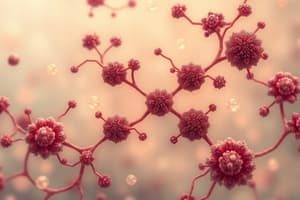Podcast
Questions and Answers
A drug with a high degree of ionization is LEAST likely to exhibit which characteristic?
A drug with a high degree of ionization is LEAST likely to exhibit which characteristic?
- Enhanced renal excretion due to increased water solubility.
- Decreased distribution to lipophilic tissues.
- Increased ability to cross cell membranes. (correct)
- Reduced absorption in the gastrointestinal tract.
Which scenario would MOST significantly affect the absorption phase of pharmacokinetics?
Which scenario would MOST significantly affect the absorption phase of pharmacokinetics?
- A patient with impaired liver function receiving an orally administered drug.
- A patient with decreased renal blood flow receiving an intravenously administered drug.
- A patient with significant small bowel resection receiving an orally administered drug. (correct)
- A patient with hypoalbuminemia receiving a highly protein-bound drug intravenously.
An acidic drug with a pKa of 4.5 is administered orally. Where is the drug MOST likely to be absorbed?
An acidic drug with a pKa of 4.5 is administered orally. Where is the drug MOST likely to be absorbed?
- The drug will be primarily absorbed in the stomach, where the acidic environment favors its unionized state. (correct)
- The drug will be absorbed equally well in both the stomach and the small intestine due to the extensive blood flow.
- The drug will be absorbed efficiently in the small intestine due to its large surface area, regardless of pH.
- The drug will not be absorbed until it reaches the colon, where bacterial activity alters its ionization.
A new drug is developed that is rapidly metabolized by gastric enzymes. Which route of administration would be the MOST effective in bypassing this first-pass metabolism?
A new drug is developed that is rapidly metabolized by gastric enzymes. Which route of administration would be the MOST effective in bypassing this first-pass metabolism?
How does the principle of pH and pKa influence drug absorption in different physiological compartments?
How does the principle of pH and pKa influence drug absorption in different physiological compartments?
Which of the following scenarios would MOST effectively trap an acidic drug like aspirin within the cells lining the stomach?
Which of the following scenarios would MOST effectively trap an acidic drug like aspirin within the cells lining the stomach?
A patient has taken an overdose of a basic drug. Which of the following strategies would BEST facilitate the renal excretion of this drug?
A patient has taken an overdose of a basic drug. Which of the following strategies would BEST facilitate the renal excretion of this drug?
A new drug is developed that is highly susceptible to first-pass metabolism in the liver. Which route of administration would be MOST appropriate to bypass this effect and maximize bioavailability?
A new drug is developed that is highly susceptible to first-pass metabolism in the liver. Which route of administration would be MOST appropriate to bypass this effect and maximize bioavailability?
A drug has a bioavailability of 40% when administered orally. Which of the following factors could contribute to this reduced bioavailability?
A drug has a bioavailability of 40% when administered orally. Which of the following factors could contribute to this reduced bioavailability?
Aspirin, an acidic drug with a pKa of 3.5, is administered to a patient. Where would the drug be MOST readily absorbed?
Aspirin, an acidic drug with a pKa of 3.5, is administered to a patient. Where would the drug be MOST readily absorbed?
Flashcards
Pharmacology
Pharmacology
The branch of science dealing with the study of drugs and their effects.
Pharmacokinetics (ADME)
Pharmacokinetics (ADME)
What the BODY does to the drug (absorption, distribution, metabolism, excretion).
Absorption (Drug)
Absorption (Drug)
Transfer of a drug from the administration site into the bloodstream.
pKa
pKa
Signup and view all the flashcards
Ionization & Absorption
Ionization & Absorption
Signup and view all the flashcards
Weak Base Absorption
Weak Base Absorption
Signup and view all the flashcards
Aspirin Absorption
Aspirin Absorption
Signup and view all the flashcards
First-Pass Metabolism
First-Pass Metabolism
Signup and view all the flashcards
Bioavailability
Bioavailability
Signup and view all the flashcards
Gut First-Pass Effects
Gut First-Pass Effects
Signup and view all the flashcards
Study Notes
- Pharmacology is the branch of science dealing with drugs
Subdivisions of Pharmacology
- Pharmacokinetics (ADME) examines the effect of the body on the administered drug.
- Pharmacodynamics examines the effect of the drug on the body.
- Pharmacokinetics is defined as the effect of the body on the drug.
Pharmacokinetics phases include:
- Absorption
- Distribution
- Metabolism
- Excretion
Importance
- It is important to tailor a dose regimen to the individual requirements of a patient.
- Tailoring is specifically important for patients with renal failure and liver disease
- Figure out the possible cause of treatment failure if a drug cannot reach the site of action or is taken by the wrong route
- Ascertain the cause of drug toxicity
Absorption Intro
- Absorption is the transfer of a drug from the site of administration to the bloodstream.
Factors affecting drug absorption that relate to the drug:
- Lipid solubility: lipid soluble drugs are more readily absorbed
- Degree of ionization: the greater the ionization, the lesser the absorption
- Stability of gastric acid and digestive enzymes
- Benzyl-penicillin and insulin are destroyed in the GIT
Factors affecting drug absorption that relate to the patient:
- Route of administration - IV is faster
- Absorbing surface area is a factor
- Specific factors such as intrinsic factor is needed for Vitamin B12 absorption
Effect of pH, pKa on Drug Ionization, and Lipid Solubility
- Unionized-lipid and ionized- less lipid soluble pass through basic and acidic media
- pKa is the pH at which 50% of the drug is ionized and 50% is unionized.
- Aspirin has a pKa of 3.5.
- Calculation: Pka (of the drug) = PH (of the media) + log unionized /ionized.
Principles
- Unionized drugs are more lipid soluble and easily absorbed
- Most drugs are weak acids or bases
- Weak acids are better absorbed in acidic media where it is less ionized
- Weak bases are absorbed in alkaline media where it is less ionized
- Aspirin is an acidic drug with Pka 3.5, in media with PH 3.5 aspirin will be half ionized, and half unionized.
- The more acidic the medium the more the absorption of aspirin.
Clinical Significance
- Knowing the site of drug absorption helps our understanding of how drugs work in the body
- Acidic drugs, such as aspirin, are largely unionized in gastric acidic PH and are absorbed from the stomach
- Bases, such as atropine, are largely ionized and absorbed only when they reach the intestines.
Ion trapping
- Acidic drugs are largely unionized in gastric lumen, so aspirin passes into cells lining the stomach
- Once entered into the a cell find the pH is alkaline where it is ionized and trapped
Treatment of drug toxicity
- Alkalization of urine decreases renal reabsorption, so increase renal excretion of acid drugs such as aspirin
- Acidification of urine increase renal excretion of basic drugs.
First-Pass Metabolism (Presystolic Elimination)
- The metabolism of drugs at the site of administration before reaching systemic circulation
- For example, GIT or liver after oral administration
Types of first pass effect:
- Gut: Gastric acidity destroys benzyl penicillin and digestive enzymes destroy insulin
- Hepatic: Nitroglycerine is one such example
To avoid high first pass effect:
- Change the route of drug administration
- An example of this is nitroglycerine being given sublingually
- Increase the oral dose
Bioavailability
- The fraction of the drug that reaches the systemic circulation in the unchanged form
- Bioavailability is 100% after IV administration
- It is variable after oral administration
- For example, if 100 mg of a drug are administered orally and 70 mg are absorbed unchanged, the bioavailability of this drug is 70%
Factors Affecting Bioavailability
- Absorption: the more drug absorption the higher the bioavailability
- First pass metabolism: the more first pass metabolism, the less the bioavailability
Studying That Suits You
Use AI to generate personalized quizzes and flashcards to suit your learning preferences.




